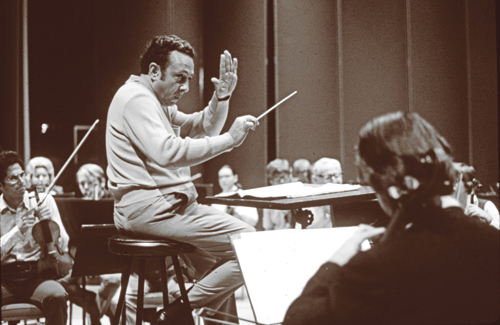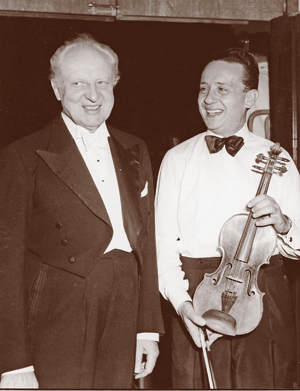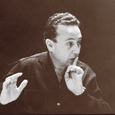
Anshel Brusilow has had a long and varied career first as a violinist with the Cleveland and then Philadelphia Orchestras. He left his position as concertmaster in Philadelphia to conduct full time, starting a chamber orchestra and later taking the conductor position with the Dallas Symphony Orchestra. After his departure from Dallas, Brusilow led the orchestra programs at the University of North Texas and Southern Methodist University.
He recalls an early revelation from his career in Philadelphia. “Not every player will have the skill of Jascha Heifetz. I remember very well when I came to the Philadelphia Orchestra and met with Eugene Ormandy. He said, ‘Feel free to change any bowings that you like, but remember, you’re changing the bowings for the people who cannot do the same bowings you can. Not all the violinists have your bow arm, so take that into consideration.’ In Philadelphia I thought this was rather strange. It was a great orchestra and still is, but I took it into consideration. However, every once in a while I would have fun with my colleagues and say something like, ‘In this passage, everybody have an upbow staccato here.’ I would show them what I meant and they asked, ‘What are you doing?’ I would respond, ‘Well, you’re the Philadelphia Orchestra, you can do that.’ Of course, they just laughed at me. It was my way of livening up rehearsals, and usually it worked.”
What were the most important lessons about music you learned from your parents?
My parents had a great influence over me, and there is no way I could have had any kind of career without their assistance. They taught me to take music seriously and how to practice correctly. My mother guided my practice every day for 81⁄2 years. Parental involvement is essential for young musicians, and it was from my parents that I learned what I was supposed to do.
What did you learn from your early teachers?
I was fortunate with my first teacher, William F. Happich, in that his teaching created a marvelous, solid foundation, and for a young musician that is important. My approach to the violin was slow – slower than most young people today. Maybe I didn’t have the greatest of talent at the beginning, and maybe I needed to go slowly; I am unsure. I always appreciated that I did not have the Tchaikovsky Violin Concerto when I was nine or Paganini when I was ten. That would have been deadly. Those all came much later. I played music that was fitting for me and progressed slowly. He helped bring the sound of the violin together from one bow to another, making long phrases rather than broken ones. He also taught me how the bow went from the tip to the frog without that breakage. These are extremely important skills to learn.
I also had a class with him in harmony and counterpoint. He would present me with melodic lines and assign me to write the counterpoint for the next lesson. This was tremendously important for me in ways I never knew until I started conducting.
I was accepted to the Curtis Institute of Music at age 11. At that time, Efrem Zimbalist, who took me as a student, was still playing concerts quite a bit, so I had few lessons with him and studied mostly with his assistant, Frederick Vogelgesang, who did as much for me as was possible. At Curtis, I also learned solfege, and had lessons in a class with Madame Mekel who picked on me to bring the violin and transpose. Most violinists cannot transpose. I don’t know why it is so difficult, but I learned to do it, and it became important later on in life for reading scores with horn parts in various keys and hear them correctly.
After Curtis, I studied with a man named Jani Szanto, who taught me how to have something to say in music and was a tremendous influence on me. I give him great credit. If he knew that I was unhappy trying to play all the Paganini Caprices, he gave me the Paganini Concerto. I was delighted to learn to play that.
 What was the key to the sound of the Philadelphia Orchestra under Leopold Stokowski?
What was the key to the sound of the Philadelphia Orchestra under Leopold Stokowski?
Leopold Stokowski’s sound came in part from his chutzpah for the music and the musicians. He made composition changes that always made the music better, and when you heard the Philadelphia Orchestra, you were hearing Stokowski’s inscription. When you employ an orchestra of 95 players, including full woodwind, brass, and percussion sections, you have to play them. You’re paying them, so you cannot have concerts without them. Stokowski added the players, and when you add the extra wind players it gives you a fantastic sound. People say “that’s the Philadelphia Orchestra,” and it was, but it was because of Stokowski. Ormandy did the same thing, and I did likewise at the University of North Texas. The orchestra was never just two flutes, two oboes, and two clarinets; I shifted and doubled lines and wrote out parts so students knew what to play. It gave more players the experience to play these tremendous compositions. Unfortunately, this is unheard of today.
What were to most important lessons you learned about conducting and how did you pick them up?
I do not believe conducting can be taught, but someone can learn by watching excellent conductors. From Szell and Ormandy I learned how to rehearse, how to find the pitfalls in the score, how to balance the orchestra, how to find the right themes and project them, what to bring forth, and what to hold back. It is even possible to learn from poor conductors; you learn what not to do.
What is the most common conducting mistake you see?
The most common conducting mistake is not knowing the score. Conducting is the most misunderstood of all the orchestral positions. There are some conductors who think that the better the orchestra, the less you have to know, but that is not entirely true. You have to learn where the mistakes are going to be and try to explain this in advance, and few conductors can.
What are the most common comments you found yourself making from the podium in rehearsals?
Almost all orchestras make the same mistake in the same place, so that’s what you look for, and nine out of ten times, you will be right. If you are incorrect in your guess and the orchestra plays well, compliment them. Compliment as much as possible.
A good conductor also has to learn to say, “I’m sorry. That was my fault.” It is important for conductors to acknowledge that they are humans who make mistakes, and the ability to be able to say that to an orchestra is important.
Never stop the orchestra without giving a reason why you stopped. Do not just say, “Let’s go back.” Tell them why you stopped. Some conductors will repeat a section just to make up time or to make the orchestra do it again. That is ridiculous, but some conductors get distracted by their work, then look at the clock, see that they have finished half an hour early, and conclude that they need to find something else to do. If you have accomplished what you want, a professional conductor can dismiss early. I used to resent when conductors took the entire amount of time, to the minute, instead of simply getting their work done.
How does tempo relate to knowledge of the instruments?
Tempos require knowing what the instruments can do at a certain tempo and then never exceeding that, because if you exceed it, musicians will be unable to play it. Always go a shade under what they are supposed to do. This is why an orchestra conductor has to know something about the stringed instruments. A conductor who lacks expertise in strings should emulate George Szell by studying every possible book about string instruments. A fine concertmaster and principals can be of assistance, but most conductors without a string instrument background are going to struggle knowing what the strings can and cannot do. This is especially important for tempos; if you know the violin and know how fast violinists can tremolo a passage, that will tell you how fast, at maximum, the conductor should take it, because the string players can only play it so fast. If a conductor goes too fast, it won’t work.
Even if a composer gives you a tempo marking, this is just what he thinks he would like to have played. It is entirely up to the conductor to find what he wants to recreate. Tempos fluctuate and are up to the individual. I am terribly annoyed by some critics who criticize conductors’ tempos by saying it is not what the composer wanted. This is beside the point. They ought to listen to one of the old recordings of Mengelberg’s, Furtwangler’s, or Nikisch’s version of Beethoven’s Fifth Symphony. When you went to a concert, and Mengelberg was conducting Beethoven’s Fifth, you were hearing Mengelberg’s Fifth. That was what Beethoven would have heard.
What was your approach to teaching concert programming?
When I taught at the university, I made it simple. Programming should be 80-85 minutes of music at maximum. You program loud, soft, loud, intermission, soft, loud. This is programming simplified, and I learned it from Alex Hilsberg, concertmaster of the Philadelphia Orchestra from 1935-51. Programming is comparable to making a dinner. There are certain herbs that work with certain meats. Find the right herbs, and don’t overdo it.
Also, avoid two works in the same key together. You will put your audience to sleep. Furthermore, if you start with D major, don’t end with it. It makes the concert seem boring.
What differences are there in working with professional musicians versus college students?
There is no difference except professional musicians can play the major works because they already know them. Students are capable of playing the same works, but if they have never played them before, they do not know them. That’s the difference. With that in mind, it is worth noting that if you treat the students like professionals, you will achieve something very special.
Anshel Brusilow’s memoir (co-written with Robin Underdahl) is Shoot the Conductor: Too Close to Monteux, Szell, and Ormandy (University of North Texas Press).





